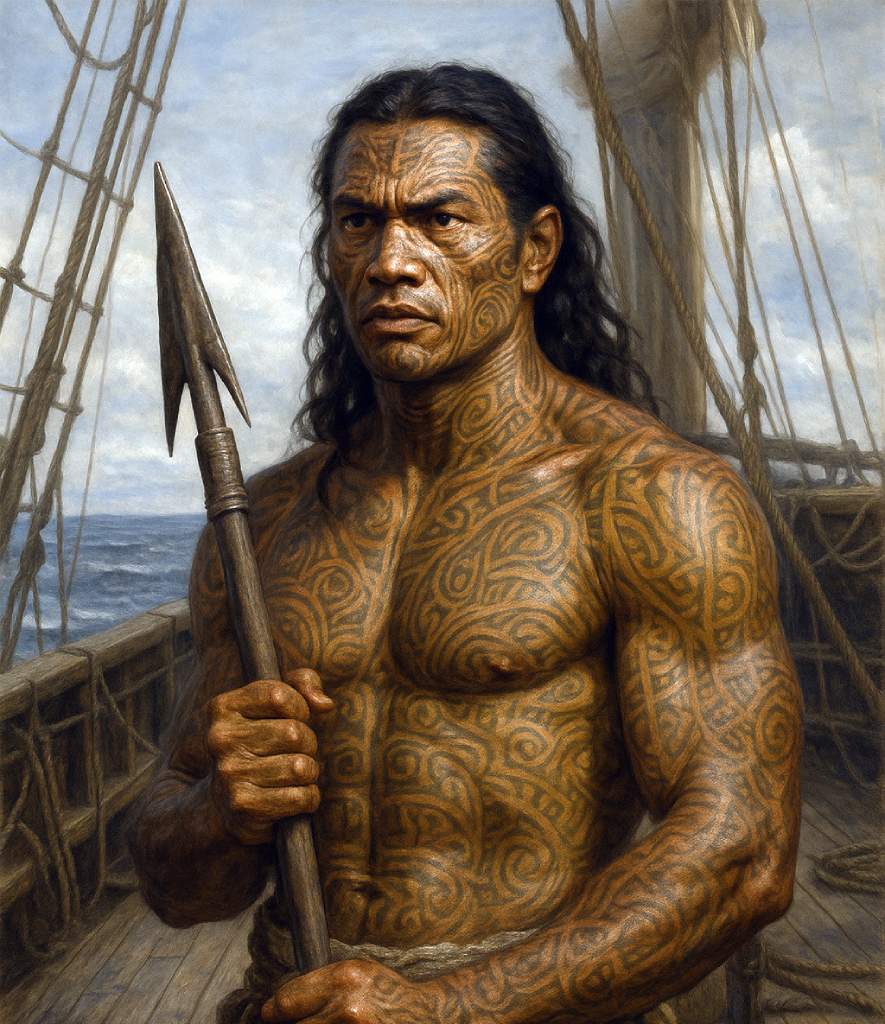In Moby Dick (1851), Herman Melville introduces Queequeg as one of the most vivid and enigmatic figures aboard the Pequod. When Ishmael first encounters him at the Spouter-Inn, Queequeg appears alien and threatening—tattooed, silent, and seemingly dangerous. Yet through the unfolding friendship between them, Melville transforms that initial fear into admiration and intimacy, which enables Queequeg to emerge as a central moral presence within the novel.
Queequeg’s transformation from an outsider to a trusted friend mirrors the novel’s meditation on connection across boundaries of race, culture, and belief. His courage, faith, and quiet dignity serve as a steady moral counterpoint to Captain Ahab’s consuming drive. As the voyage deepens, he ceases to be defined by exoticism or strangeness and instead emerges as a figure of composure and generosity—an anchoring presence within the destructive ambitions that propel the Pequod toward its fate.
Character Analysis
Origin and Appearance
- Polynesian harpooner: Queequeg hails from the fictional island of Rokovoko (also called Kokovoko), a remote Pacific island. As a harpooner on the Pequod, he brings unusual skill and fearlessness to whaling.
- Tattoos, cannibal stereotype, and subversion: Ishmael initially views Queequeg with suspicion: his body is covered with tattoos, and Ishmael fears cannibalism. But as their relationship deepens, Melville uses this imagery to invert prejudice: the “savage” proves more human, dignified, and generous than many “civilized” characters.
Culture and Belief
- Animistic faith and Yojo: Queequeg practices a pagan (non-Christian) religion, marked by reverence for a small idol named Yojo, periodic fasting and quietude, and ritual practices. He sometimes locks himself in silence (what Ishmael terms his “Ramadan”). This serves to contrast Christian norms aboard the ship and to remind readers that religious difference need not imply moral inferiority.
- The coffin as sacred text: When Queequeg falls ill, he requests a coffin shaped like a canoe. He carves into it the motifs of his tattoos, replicating his body on this vessel. After his recovery, that coffin later becomes Ishmael’s life-buoy when the Pequod sinks.
Queequeg and Ishmael
- From suspicion to “marriage”: The relationship between Ishmael and Queequeg begins awkwardly. At the Spouter-Inn, they are assigned to share a bed, and Ishmael fears Queequeg might be a cannibal. But one night, Queequeg throws his arm over Ishmael in sleep; Ishmael remarks, “You had almost thought I had been his wife.” In Chapter 10, Queequeg declares they are “married”—that is, bosom friends who join their fates.
- Mutual influence and empathy: Through their bond, Ishmael learns to perceive Queequeg beyond stereotypes. He comes to see Queequeg as principled, skillful, and generous. Their friendship extends the novel’s theme of companionship across racial, cultural, and religious divides, and their bond becomes a subtle critique of ethnocentrism.
Symbolic Roles and Themes
- Otherness, fellowship, and race: Queequeg embodies “otherness,” but Melville humanizes him to challenge readers’ prejudices. In the novel’s deployment of race and fellowship, Ishmael’s initial terror transforms into respect and affection, making their relationship a central illustration of racial tolerance.
- Natural man and moral exemplar: Some critics interpret Queequeg as a “natural man” figure, not corrupted by the ideals and failings of Western civilization. His courage, loyalty, and honor frequently outstrip those of supposedly “civilized” men. In moments of danger, he rescues crew members, including a mocker and Tashtego.
- Bridge between life and death: Queequeg’s coffin becomes both his symbolic tomb and the literal instrument of Ishmael’s survival. When the Pequod sinks, that coffin-turned-lifebuoy surfaces; Ishmael clings to it until rescued. In this way, Queequeg acts as a protective spirit beyond death: his vessel sustains his friend’s life.
Queequeg’s Fate and Legacy
- Illness, recovery, and self-renewal: In Chapter 110, Queequeg falls into a fever so grave that his death appears imminent. He instructs the building of the canoe-coffin. At the brink, he revives, getting resurrected through willpower and reminding himself of duties left unfinished.
- Final disappearance and metaphoric martyrdom: Queequeg does not survive the sinking of the Pequod; he vanishes in the same catastrophe that kills nearly all aboard, except Ishmael. Yet, his earlier gestures of friendship, sacrifice, and identity continue to influence Ishmael’s narrative arc. Some critics see Queequeg as a sacrificial figure who, through his objecthood (the coffin), ensures Ishmael’s rebirth.
- Enduring resonance: The character of Queequeg endures as a symbol of compassion and moral presence in Moby Dick. Across generations, Queequeg remains a touchstone for scholars and readers discussing identity, friendship, and faith. Some regard him as Ishmael’s spiritual counterpart, the one who steadies the narrator’s gaze despite the turmoil of the hunt. Melville leaves him firmly human: mysterious, self-contained, and unforgettable.
Further Reading
Queequeg on Wikipedia
Character Analysis of Queequeg by CliffNotes
Great book, but I’m a little bit disapointed by Queequegs role in the later parts of the book on Reddit
Tied By Cords Woven of Heart-Strings: A Study of Manhood in Herman Melville’s Moby Dick by Veronica Faller, Boston University Arts & Sciences




